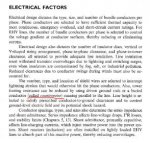- Location
- Lockport, IL
- Occupation
- Retired Electrical Engineer
I have received a question from the field regarding a specification requirement they want me to delete. It was part of the boilerplate spec, meaning that I did not write it, and I did not elect to edit it out. The requirement is to run a 4/0 bare copper grounding conductor above (or below, at the option of the designer) any medium voltage ductbank. This conductor is connected to the ground rings of any manholes or equipment pads (e.g., for a pad-mounted transformer). Before I answer the field question, can anyone shed any light on the following questions:
- What does this thing do for a living?
- What would it be called (i.e., it's neither an EGC nor a GEC)?
- Why would the spec say to install it outside the concrete encasement?
- Is this a common requirement, and would it only apply to medium voltage?

